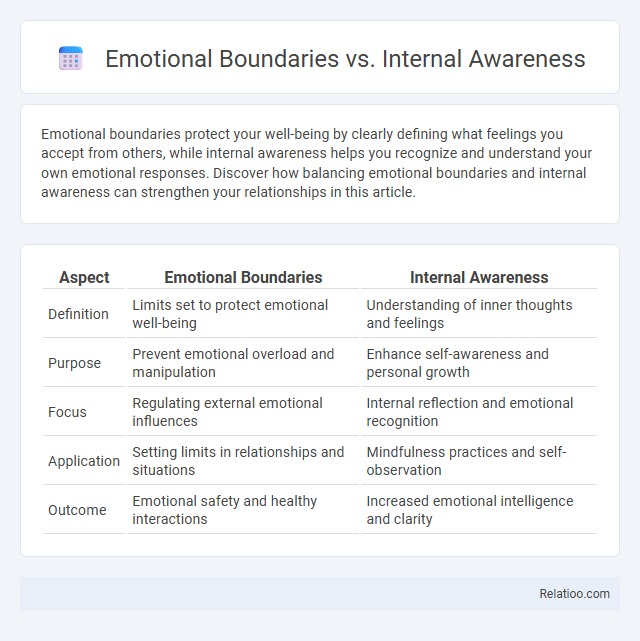Emotional boundaries protect your well-being by clearly defining what feelings you accept from others, while internal awareness helps you recognize and understand your own emotional responses. Discover how balancing emotional boundaries and internal awareness can strengthen your relationships in this article.
Table of Comparison
| Aspect | Emotional Boundaries | Internal Awareness |
|---|---|---|
| Definition | Limits set to protect emotional well-being | Understanding of inner thoughts and feelings |
| Purpose | Prevent emotional overload and manipulation | Enhance self-awareness and personal growth |
| Focus | Regulating external emotional influences | Internal reflection and emotional recognition |
| Application | Setting limits in relationships and situations | Mindfulness practices and self-observation |
| Outcome | Emotional safety and healthy interactions | Increased emotional intelligence and clarity |
Understanding Emotional Boundaries
Understanding emotional boundaries involves recognizing and respecting personal limits in feelings and interactions to maintain psychological well-being. Emotional boundaries differentiate where one person's emotions end and another's begin, preventing emotional enmeshment and fostering healthy relationships. Developing internal awareness and practicing regular introspection enhance clarity about these boundaries, enabling individuals to respond to emotional experiences with greater self-control and empathy.
Defining Internal Awareness
Internal awareness involves your conscious recognition of thoughts, emotions, and bodily sensations, serving as the foundation for effective emotional boundaries. Developing internal awareness enhances your ability to distinguish between your feelings and external influences, fostering healthier interactions and self-regulation. Introspection builds on this by encouraging deeper self-examination, but internal awareness remains the critical first step in cultivating emotional intelligence.
Key Differences Between Boundaries and Awareness
Emotional boundaries define your limits for how others can affect your feelings, protecting your personal space and autonomy, whereas internal awareness involves recognizing and understanding your emotions in real-time without judgment. Introspection goes deeper as a deliberate self-examination process to uncover underlying motivations and patterns influencing your emotions and behavior. Your emotional boundaries regulate outer interactions, internal awareness monitors present emotional states, and introspection facilitates profound self-discovery and growth.
The Role of Emotional Boundaries in Relationships
Emotional boundaries play a crucial role in relationships by defining personal limits that protect individual feelings and prevent emotional enmeshment or dependency. Internal awareness enhances the ability to recognize and respect these boundaries by fostering a deep understanding of one's emotions and needs. Introspection supports this process by encouraging continuous self-reflection, which helps maintain healthy interactions and emotional balance in partnerships.
Cultivating Internal Awareness for Self-Growth
Cultivating internal awareness enhances your ability to recognize emotional boundaries by understanding the subtle signals your mind and body send during interactions. Emotional boundaries protect your well-being, but internal awareness allows for deeper introspection, promoting self-growth through honest self-reflection and emotional regulation. Developing this internal awareness supports clearer decision-making and healthier relationships rooted in self-knowledge.
Emotional Boundaries: Signs and Signals
Emotional boundaries are essential for maintaining personal well-being by distinguishing one's feelings from others' emotions. Signs of healthy emotional boundaries include clear communication of needs, the ability to say no without guilt, and avoiding emotional over-involvement in others' problems. Recognizing signals such as discomfort with oversharing, persistent stress, or feeling emotionally drained can indicate boundary violations requiring attention.
How Internal Awareness Influences Emotional Health
Internal awareness enhances emotional health by enabling individuals to recognize and understand their feelings before reacting impulsively. This heightened self-awareness fosters stronger emotional boundaries, helping to differentiate personal emotions from external influences and reducing emotional overwhelm. Consistent introspection promotes emotional regulation, leading to improved mental well-being and resilience.
Setting Healthy Emotional Boundaries
Setting healthy emotional boundaries involves recognizing and respecting your own feelings while maintaining awareness of others' emotions without becoming overwhelmed. By developing internal awareness, you can identify which emotions are yours and prevent emotional enmeshment, fostering balanced relationships. Introspection deepens your understanding of personal limits, enabling you to communicate your needs clearly and safeguard your emotional well-being.
Practical Steps to Enhance Internal Awareness
Setting clear emotional boundaries helps protect your mental space, while internal awareness involves recognizing your feelings and bodily sensations without judgment. Practicing mindfulness meditation and journaling daily can significantly boost your internal awareness by helping you observe thoughts and emotions objectively. Incorporate regular self-check-ins throughout your day to track shifts in mood, which deepens your connection to your inner experiences.
Balancing Boundaries and Awareness for Wellbeing
Balancing emotional boundaries with internal awareness and introspection enhances overall wellbeing by allowing individuals to recognize and respect their limits while maintaining deep self-understanding. Setting clear emotional boundaries protects mental health from external stressors, whereas introspection fosters self-reflection that promotes emotional growth and resilience. Integrating these elements cultivates a harmonious state where personal needs are honored alongside mindful awareness of internal experiences.

Infographic: Emotional Boundaries vs Internal Awareness
 relatioo.com
relatioo.com